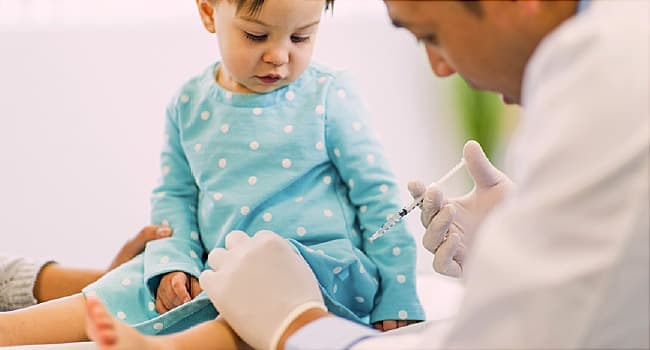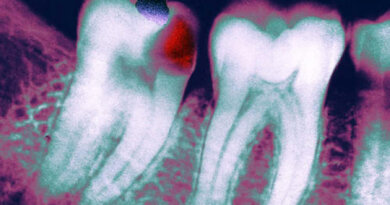A Parent’s Guide to Vaccines
The tears and screaming, as upsetting as they are, are well worth the effort. A simple prick of the skin provides children with lifetime protection against diseases like chickenpox, meningitis, and hepatitis. With a schedule starting at birth and lasting into childhood, millions of kids in the United States are vaccinated each year, usually before school begins in the fall. Mary Glodé, MD, a professor of pediatrics and chief of the infectious diseases section at the University of Colorado School of Medicine and Children’s Hospital Colorado, explains which vaccines kids should be getting and when — starting with the first shot babies receive only hours after birth.
Hepatitis B
When: The hepatitis B vaccine is a three-dose series. Before newborns leave the hospital, they are given a shot in case their mothers have the disease, which can be transmitted to a child during birth, says Glodé. Second and third doses are usually given one month and six months later. Immunity lasts for more than 20 years.
Why: Hep B is a virus that can damage the liver, causing infection and scarring, and increasing cancer risk. Kids with hep B are at high risk of becoming seriously sick — about 90% of infected infants eventually develop lifelong infection, and 25% die from liver disease.
Rotavirus
When: There are two brands of the rotavirus vaccine, one that requires two doses and one that requires three — at ages 2 months, 4 months, and 6 months, if necessary. All are given as a liquid by mouth.
Why: Rotavirus is the No. 1 cause of vomiting and diarrhea among children worldwide. The virus can also cause fever, loss of appetite, and dehydration.
The vaccine does its job well. Studies show that during a baby’s first year, the vaccine prevents more than 85% of severe rotavirus infections and more than 75% of all rotavirus infections.
Two studies show the RotaTeq and Rotarix vaccines carry a small increased risk of intussusception — a condition in which the small bowel folds back inside another part of the intestine, causing a bowel obstruction. Researchers conclude the benefits of the vaccines outweigh the risk of intussusception.
Diphtheria-Tetanus–Pertussis (DTaP)
When: “This was the first combination vaccine made,” says Glodé. “The purpose was to simply minimize the number of times a pediatrician needs to poke a child.” DTaP follows a five-dose schedule: at 2, 4, 6, and 15 to 18 months, and then again between 4 and 6 years of age. Immunity lasts at least 10 years.
Why: This one shot protects against three dangerous diseases. Diphtheria is a respiratory disease that can lead to breathing problems and, potentially, paralysis, heart failure, and death. Tetanus is a bacterial infection that can cause muscle spasms that tear muscle tissues or fracture the spine. Pertussis, known as whooping cough, is a highly contagious respiratory infection that causes coughing so powerful and prolonged that a child may stop breathing during an episode.
Haemophilus Influenzae Type B
When: The haemophilus influenzae type b bacteria (known as Hib) vaccine is given at 2 and 4 months of age, and again at 6 months if a third dose is necessary. (This depends on the brand of vaccine used.) The final dose is given at 12 to 15 months and protects a child until his own immunity kicks in several years later.
Why: The Hibbacteria causes meningitis, an infection of the membranes covering the brain and spinal cord that can lead to deafness and death. It’s also one of the bacteria behind pneumonia, as well as bone and joint infections that cause septic arthritis, or inflammation of the joints.
“Infants are born with an immunity to Hib they get from their mother,” Glodé says. “But that natural immunity is gone by 6 months. Then, through exposure, you gain immunity again around age 5 or 6.”
Pneumococcal Disease
When: “There are roughly 100 different strains of the pneumococcus bacteria that can cause infection in children,” Glodé says. “First, the PCV vaccine covered seven of these strains, but it was updated in 2010 to cover 13 of the most severe strains — so now it’s called PCV 13.”
The PCV, or pneumococcal conjugate vaccine, is given in four doses at 2, 4, and 6 months, with a final dose at 12 months or older.
Why: A bacterium called Streptococcus pneumoniae can cause blood infections, pneumonia, and pneumococcal meningitis. (Like meningitis, this infection causes swelling and irritation of the membranes covering the brain and spinal cord.) It’s particularly dangerous for kids under 2 with developing immune systems. The bacterium has become resistant to some antibiotics, so the PCV vaccine is more important than ever.
When: This is given as a shot over four doses, at 2, 4, and 6 to 18 months of age, with a booster between 4 and 6 years.
Why: Polio is a virus that can cause paralysis and, eventually, death by paralyzing the muscles that help a person breathe. It infected thousands of people a year in the United States before vaccination began in 1955, successfully eliminating the disease in this country. But because polio still exists elsewhere around the world, it’s important kids are protected, Glodé explains.
MMRV
When: The MMRV vaccine is given at 12 to 15 months of age, then again at 4 to 6 years.
Why: It’s a mouthful — measles, mumps, rubella, and varicella. And you don’t want your child to be infected with any of them. Measles can cause rash, cough, and fever and lead to ear infections, pneumonia, and possibly death. Mumps can cause fever, headache, and swollen glands and lead to deafness, meningitis, and swelling of the testicles or ovaries. Rubella causes rash, fever, and sometimes arthritis. Finally, varicella, or chicken pox, can cause rashes, itching, fever, and fatigue, leading to skin infections and scars. In rare cases it can cause encephalitis, an infection of the brain.
Hepatitis A
When: The hep A vaccine is given between ages 1 and 2, and again six months later.
Why: Hepatitis A is a liver disease that can cause jaundice and severe diarrhea; one in five of those infected needs to be hospitalized. While kids aren’t at significant risk of becoming seriously ill from hepatitis A, adults are, Glodé says. Vaccinations in children are aimed partially at protecting older family members and caregivers.
When: Once a year, starting at 6 months, kids should be vaccinated against influenza. Kids 2 and older who do not have asthma or a compromised immune system can get the flu vaccine in nasal spray form.
Why: The flu shot contains killed flu virus, and each version protects against the three most likely strains to infect people that year, based on research of the most active strains worldwide, Glodé says. When scientists get the strains right, research shows, the vaccine can prevent the flu in more than 70% of healthy, young people.
Are Vaccinations Safe?
Vaccines have come a long way since the first one was developed for smallpox more than 200 years ago. Today, research shows they are safer than ever. With side effects usually both mild and infrequent, the advantages far outweigh the risks in terms of protecting a child’s health for years to come, Glodé says. “Vaccines must go through rigorous testing before they become available to the public.”
Though vaccines as a possible cause of autism has been a topic of dispute for years, study after study has found no such link. “Autism is a very serious disease that needs to be studied, but the evidence connecting it to vaccines just isn’t there,” says Glodé.
Countless studies back the health benefits of vaccinations. These findings help parents make what most, if not all, kids’ health experts say is the right choice: protection through vaccines.
Vaccination Side Effects
The side effects of vaccines are usually few and far between, and generally mild. If they do happen, here’s what parents might see. If you’re concerned, call your doctor.
Hepatitis B: Soreness where the shot was given, fever.
Rotavirus: Irritability, mild diarrhea, vomiting.
Diphtheria-Tetanus-Pertussis (DTaP): Fever, fussiness, vomiting, lack of appetite for a few days, fatigue.
Haemophilus Influenzae Type B: Soreness where the shot was given, fever.
Pneumococcal Disease: Drowsiness, soreness where the shot was given, fever, fussiness.
Polio: Soreness where the shot was given.
MMRV: Fever, seizure caused by fever, mild rash, swollen glands.
Hepatitis A: Soreness where the shot was given, headache, loss of appetite, fatigue.
Flu: Low fever, muscle aches. Very rarely (one or two in a million people)
Find more articles, browse back issues, and read the current issue of “WebMD the Magazine.”




